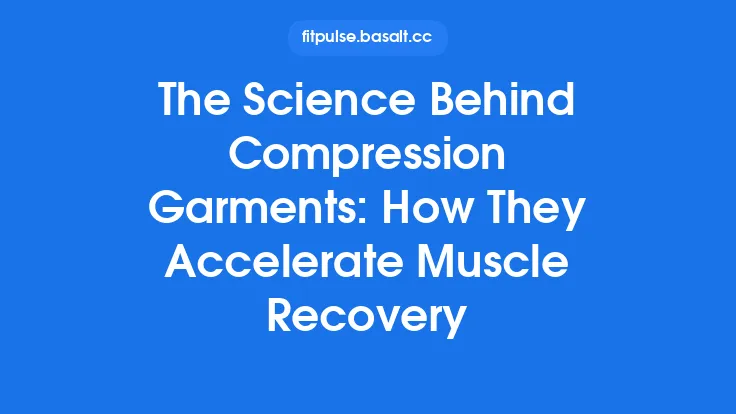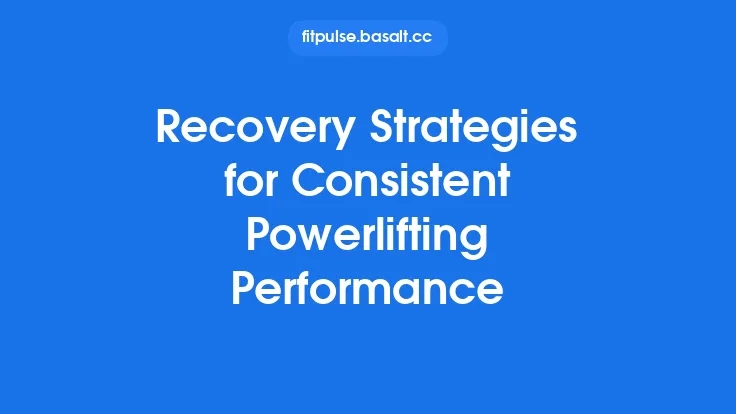When it comes to post‑workout recovery, the gear you wear can be just as important as the stretches you do or the nutrition you consume. Compression garments—ranging from socks and sleeves to full‑leg tights and upper‑body pieces—have become a staple in many athletes’ recovery kits. Yet the market is flooded with options that differ in material, compression rating, design, and intended use. Selecting the right garment isn’t a matter of “the more compression, the better.” It requires an understanding of how compression works, what your body needs after a particular type of training, and how to match those needs with the garment’s specifications. This guide walks you through the science, the variables, and the practical steps to help you make an informed choice that supports optimal recovery.
Understanding How Compression Aids Recovery
The Physiology of Compression
Compression garments apply graduated pressure to the skin and underlying tissues. This pressure creates a mechanical environment that influences several physiological processes:
| Process | How Compression Helps |
|---|---|
| Venous return | By narrowing the veins, compression encourages blood to flow back toward the heart, reducing pooling in the lower extremities. |
| Lymphatic drainage | The gentle squeeze assists the lymphatic system in clearing metabolic waste, such as lactate and inflammatory cytokines. |
| Micro‑circulation | Improved capillary blood flow delivers oxygen and nutrients more efficiently to fatigued muscles. |
| Muscle oscillation reduction | During movement, muscles vibrate; compression dampens this oscillation, decreasing micro‑trauma and perceived soreness. |
| Proprioceptive feedback | The tactile stimulus can enhance body awareness, potentially improving movement patterns in subsequent sessions. |
These mechanisms are most effective when the compression is graduated—higher at the distal end (e.g., ankle) and gradually decreasing proximally (e.g., calf). This gradient mimics the natural pressure profile of the circulatory system and maximizes fluid return.
Evidence Snapshot
- Blood flow: Doppler ultrasound studies show a 10‑30 % increase in venous velocity when wearing class II compression (15‑21 mmHg) versus no compression.
- Delayed onset muscle soreness (DOMS): Meta‑analyses of randomized trials report a modest reduction (≈ 0.5‑1 point on a 10‑point VAS) in soreness 24‑48 hours post‑exercise when garments are worn for 6‑24 hours.
- Performance recovery: Athletes who used compression tights for 12 hours after high‑intensity interval training demonstrated faster restoration of sprint speed and jump height compared with control groups.
While the magnitude of benefit varies with garment type, compression level, and individual response, the consensus is that well‑designed compression wear can accelerate the clearance of metabolic by‑products and reduce perceived fatigue.
Key Variables to Consider
1. Compression Rating (mmHg)
Compression is measured in millimeters of mercury (mmHg). The rating determines how much pressure the garment exerts on the tissue.
| Rating | Typical Use | Approx. Pressure |
|---|---|---|
| Class I (8‑15 mmHg) | Light support, everyday wear, mild swelling | Light, barely perceptible |
| Class II (15‑21 mmHg) | Moderate recovery, post‑run, moderate edema | Noticeable, comfortable |
| Class III (21‑34 mmHg) | Severe swelling, post‑surgery, high‑intensity recovery | Firm, may feel tight |
| Class IV (≥ 34 mmHg) | Medical prescription only (e.g., deep‑vein thrombosis) | Very firm, not for routine athletic use |
For most recreational and competitive athletes, Class II offers the best balance of efficacy and comfort. Class III may be appropriate for elite athletes undergoing extremely taxing sessions or for those with a history of pronounced swelling.
2. Material Composition
| Material | Pros | Cons |
|---|---|---|
| Nylon/Spandex blends | High elasticity, lightweight, moisture‑wicking | May retain odor if not treated |
| Polyester/Elastane | Durable, good UV resistance, quick‑dry | Slightly less stretch than pure spandex |
| Natural fibers (e.g., bamboo, merino wool) | Antimicrobial, temperature regulation | Lower compression consistency, higher cost |
| Compression‑specific polymers (e.g., Lycra® Power) | Engineered for precise pressure gradients | Premium price point |
Look for fabrics that incorporate anti‑odor treatments (silver ions, copper-infused yarn) and moisture management (quick‑dry finishes). These features keep the garment comfortable during prolonged wear and reduce the risk of skin irritation.
3. Fit and Sizing
A proper fit is non‑negotiable. Too loose, and the garment won’t deliver the intended pressure; too tight, and it can impede circulation.
- Measure circumference at the intended wear location (e.g., calf at its widest point, thigh at the midpoint).
- Consult the brand’s sizing chart—many manufacturers provide a “compression fit guide” that correlates measurements with size.
- Try it on while standing; the garment should feel snug but not painful. You should be able to slide a finger under the edge without excessive resistance.
Some brands offer custom‑fit services where you submit detailed measurements and receive a garment tailored to your exact dimensions. This is especially valuable for athletes with atypical limb shapes (e.g., muscular calves, slender shins).
4. Design Features
| Feature | Benefit |
|---|---|
| Seamless construction | Reduces friction points, lowers risk of chafing during movement. |
| Targeted compression zones | Reinforced panels over high‑stress areas (e.g., calf muscle belly) provide extra support where it’s needed most. |
| Open‑toe or open‑heel options | Allows for footwear compatibility and easier on/off for athletes who need to transition quickly. |
| Compression sleeves vs. full tights | Sleeves are ideal for localized recovery (e.g., calf or forearm), while full tights provide systemic benefits for the entire lower body. |
| Integrated compression socks with calf sleeves | Offers a “two‑piece” system that can be mixed and matched for varying levels of support. |
When selecting a garment, consider the type of training you typically perform. Runners often benefit from calf sleeves combined with compression socks, whereas weightlifters may prefer full‑leg tights that support the quadriceps, hamstrings, and glutes.
Matching Garments to Recovery Goals
| Goal | Recommended Garment Type | Compression Rating | Wear Time |
|---|---|---|---|
| Reduce muscle soreness after a long run | Compression socks + calf sleeves | Class II (15‑21 mmHg) | 6‑12 hours post‑run |
| Accelerate recovery after high‑intensity interval training (HIIT) | Full‑leg compression tights | Class II‑III (15‑30 mmHg) | 12‑24 hours, preferably overnight |
| Alleviate swelling from a heavy leg day (squats, deadlifts) | Thigh‑to‑ankle compression tights | Class III (21‑34 mmHg) | 12‑18 hours, monitor comfort |
| Support upper‑body muscles after rowing or swimming | Compression sleeves (biceps, forearm) | Class I‑II (8‑21 mmHg) | 4‑8 hours during and after session |
| Daily maintenance for athletes with chronic mild edema | Light‑compression socks (Class I) | 8‑15 mmHg | Throughout the day |
Timing matters: For maximal benefit, put on the garment immediately after training (within 30 minutes) while the circulatory system is still primed for fluid exchange. If you cannot wear it right away, aim to start within 2 hours.
Practical Tips for Using Compression Garments Effectively
- Warm‑up before compression – Light activity (5‑10 minutes of walking or gentle cycling) before donning the garment can enhance blood flow and improve the garment’s fit.
- Gradual compression increase – If you’re new to higher‑pressure garments, start with a lower class and progress over a week to allow your tissues to adapt.
- Avoid excessive wear – Prolonged compression (beyond 24 hours) can lead to skin maceration or reduced arterial inflow. Follow manufacturer recommendations and listen to your body.
- Combine with active recovery – Light mobility work, foam rolling, or low‑intensity cardio while wearing the garment can synergistically boost circulation.
- Monitor skin health – Check for redness, numbness, or tingling. If any of these symptoms persist, remove the garment and allow the area to rest.
Maintenance and Longevity
Proper care extends the functional life of compression wear and preserves its pressure profile.
| Care Step | Reason |
|---|---|
| Hand wash in cold water | Hot water can degrade elastic fibers, reducing compression over time. |
| Use mild detergent, avoid fabric softeners | Softening agents coat fibers, diminishing stretch and pressure. |
| Air‑dry flat | Direct heat (tumble dryer) can cause shrinkage and uneven pressure zones. |
| Rotate multiple pairs | Alternating garments gives each piece time to recover its shape between uses. |
| Inspect seams and fabric | Small tears or stretched areas can compromise compression; replace when needed. |
Most high‑quality compression garments retain at least 80 % of their original pressure after 50 wash cycles. Look for brands that provide compression retention guarantees—a sign of confidence in material engineering.
Common Myths Debunked
| Myth | Reality |
|---|---|
| “More compression always equals faster recovery.” | Excessive pressure can restrict arterial inflow and cause discomfort. Optimal recovery is achieved with graduated, appropriate‑level compression. |
| “Compression works only for elite athletes.” | The physiological benefits (enhanced venous return, reduced swelling) apply to anyone engaging in strenuous activity, from weekend joggers to professional teams. |
| “You must wear them 24 hours a day for results.” | Intermittent use (post‑exercise and during sleep) is sufficient; continuous wear can lead to skin issues. |
| “All compression garments are the same.” | Differences in material, construction, compression rating, and fit dramatically affect performance. Choose based on evidence, not just brand name. |
| “Compression replaces the need for stretching.” | Compression complements, not substitutes, active recovery methods like stretching and mobility work. |
Frequently Asked Questions
Q: Can I wear compression garments during my workout?
A: Yes, many athletes wear them during training to reduce muscle oscillation and improve proprioception. However, ensure the garment’s rating is appropriate for active use (typically Class I‑II) and that it does not restrict range of motion.
Q: How long should I keep the garment on after a session?
A: Most studies suggest 6‑24 hours, with the first 12 hours being the most impactful. Overnight wear is common because the body’s restorative processes are heightened during sleep.
Q: Are there any contraindications?
A: Individuals with peripheral arterial disease, severe varicose veins, or skin infections should consult a healthcare professional before using compression wear. Also, avoid use if you experience numbness, tingling, or pain.
Q: Do compression sleeves for arms help with upper‑body recovery?
A: They can aid in reducing swelling and improving venous return in the forearms and biceps, especially after activities like rowing, climbing, or weightlifting. The effect is modest but can be part of a comprehensive recovery plan.
Q: How do I know if the compression level is right for me?
A: The garment should feel snug but not painful. You should be able to slide a finger under the edge without excessive resistance. If you notice discoloration, numbness, or a “tight” sensation, downgrade the compression class.
Putting It All Together: A Step‑by‑Step Buying Checklist
- Identify your primary recovery need (e.g., soreness, swelling, general circulation).
- Select the appropriate compression class (most athletes: Class II).
- Choose the garment type (socks, sleeves, tights) based on the muscle groups you target.
- Take precise measurements and consult the brand’s sizing guide.
- Evaluate material and design features (seamless, antimicrobial, targeted zones).
- Read reviews for durability and pressure retention; prioritize brands with transparent testing data.
- Confirm care instructions align with your routine (hand wash, air‑dry).
- Purchase a second pair for rotation and to ensure you can maintain consistent compression after each session.
By following this systematic approach, you’ll equip yourself with compression wear that truly supports your recovery goals, enhances performance, and stands the test of time.
Bottom line: Compression garments are a scientifically backed, low‑cost tool that can meaningfully accelerate post‑workout recovery when chosen wisely. Focus on the right pressure level, a proper fit, high‑quality materials, and appropriate wear time, and you’ll reap the benefits of reduced soreness, faster fluid clearance, and a quicker return to training.





